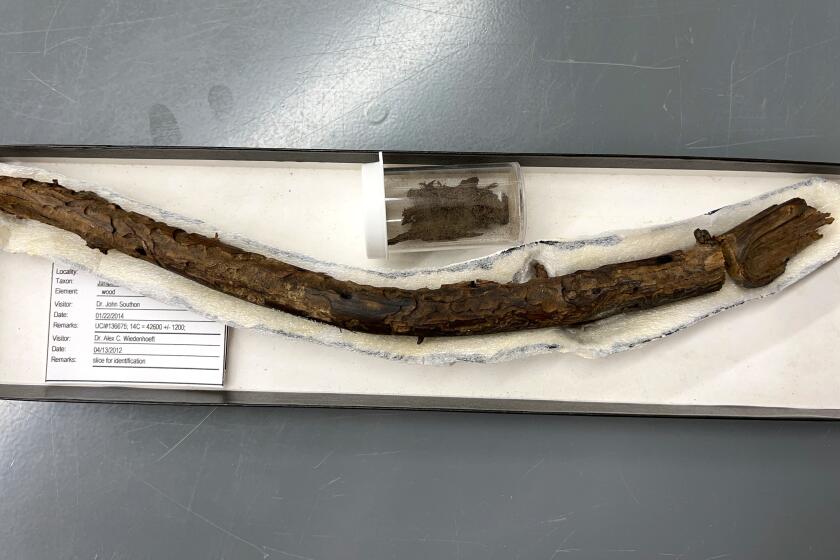3 Ways to Top-Notch Topiaries
Question: How do I create a topiary?
A.L., Fountain Valley
Answer: Topiaries are plants trained by a variety of methods to resemble an object. They are living statuary. There are three popular methods of creating topiaries: garden topiaries, moss-filled topiaries and trained topiaries.
Garden Topiaries
To create this style, place a preformed wire structure over a plant growing in the ground or a pot. Chicken wire is usually used to create the form, and the plant grows up through the structure. As it grows, it is trimmed to take the shape of the form. You see these types at Disneyland.
You can usually find a variety of wire topiary forms at nursery supply companies. When you purchase a frame, it should have an opening at the bottom large enough for the plant to grow up through it. The form should be simple and easily recognizable before planting, as it will lose some of its detail once it grows in fully.
Look for a dense, evergreen shrub with upright growth habits. Leaves should be small enough to easily grow through the openings in the wire form and maintain the integrity of the topiary shape.
In general, the smaller the leaf, the easier it is to shape. Keep in mind, however, that smaller-leaved plants will take longer to reach maturity and fill in the form. It is best to start with a small plant that can easily be coached into the frame without too much damage, rather than trying to cram a large plant into the frame. Some recommended plants are boxwood and yew.
After planting the topiary shrub in the garden or container, gently gather the plant into an upright position and tie with garden twine.
Lower the topiary frame over the plant, tucking in branches and leaves as you go; anchor it into the soil by pushing the edge of the frame into the dirt or pile soil at the base of the frame. Guide the main stem of the plant into the main portion of the frame. Once in place, remove the twine, enabling the plant branches to return to their normal position as much as possible within the frame.
Redirect lower branches out through the frame structure if possible. Trim away plant growth outside the frame to assure that the frame is covered, but the shape can be easily made out.
Tuck in or trim growth whenever needed to maintain the topiary shape.
Moss-Filled Topiaries
Easily portable, these self-contained topiaries consist of a frame filled with sphagnum moss, which is used in moss-lined hanging baskets, and an opening--often on top--with potting soil where the plant is. These topiaries can stand on the ground or a tabletop.
Heavy-grade wire or chicken wire is used to form a simple shape.
Trailing ivy with long runners and small leaves is a good plant choice because it stays close to the frame and shows the shape. You can use one large (4-inch) plant or a few smaller plugs of ivy.
Soak the sphagnum moss and the plants thoroughly before assembling. Fill the frame with wrung-out moss and hold in place with a fine-gauge fishing line or heavy thread wrapped over and over the frame. Use the moss and line to enhance the shape of the form and add character. Leave openings for inserting plants.
Once the entire frame is covered, remove the plants from their containers and gently coax their root balls into the openings in the moss. Tuck moss in around the plants to keep them tightly packed. Eventually, the roots will grow into the moss and the plants will become more stable. Use fern pins from a floral supply company or hairpins to anchor the ivy runners around the shape.
It’s important to keep a moss-filled topiary moist but not too wet. If the moss dries out, it will rob moisture from the plants. If it is too wet, it will not allow oxygen to get to the plant roots and they will die. Fertilize with an all-purpose, well-balanced fertilizer once a month. Keep in bright light, but no direct sunlight.
Trained Topiaries
This type is made of a thick wire frame in forms that plants are trained to grow up and through. You usually see these indoors and they are often made of trailing herbs.
The forms are traditional in shape and usually grown in a container. Some common forms are two or three balls on a stem, cones, wreaths and hearts. The forms usually have pointed bases used to insert into the soil and anchor the frame.
Trailing plants are typically used for this type of topiary. Ivy, rosemary, thyme and myrtle are common choices.
Choose a container plant that has long runners and plant it in a decorative pot. Insert the form base into the soil over the center of the plant. Make sure the plant is thoroughly watered so the stems are pliable. Gently wrap each plant runner around the wire, going up the form. At the end of each runner, tuck it into itself. Trim away any straggling growth that detracts from the shape of the form.
Tuck in or trim growth whenever needed to maintain the topiary shape.
* Written and researched by University of California Master Gardener Sheila Peterson of Laguna Beach.
* Omission: Last week’s Help Line on cymbidium orchid repotting was written by University of California Master Gardener Mary Steele of Laguna Niguel.
Have a problem in your yard? University of California Cooperative Extension (UCCE) Master Gardeners are here to help. These trained and certified horticultural volunteers are dedicated to extending research-based, scientifically accurate information to the public about home horticulture and pest management. They are involved with a variety of outreach programs, including the UCCE Master Garden hotline, which provides answers to specific questions. You can reach the hotline at (714) 708-1646 or send e-mail to ucmastergardeners@yahoo.com. Calls and e-mail are picked up daily and are generally returned within two to three days.



